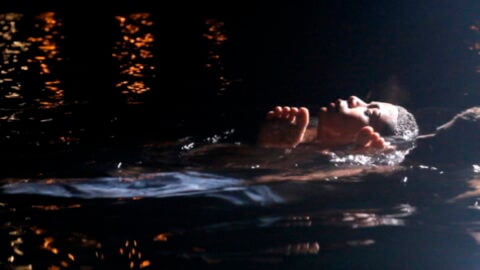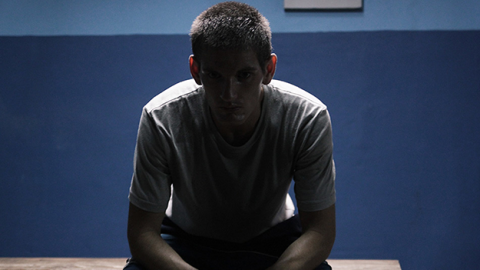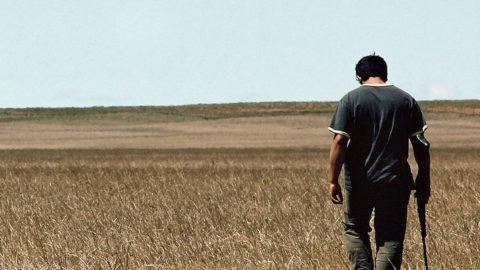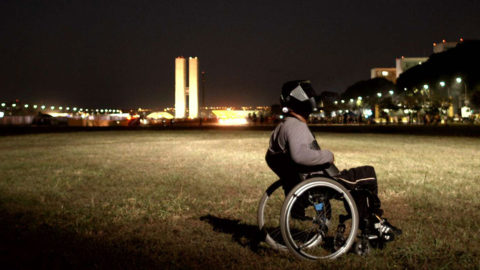Locarno Voices: Good Manners and Le Fort des Fous
Good Manners screens April 5 and April 6 at New Directors / New Films 2018.
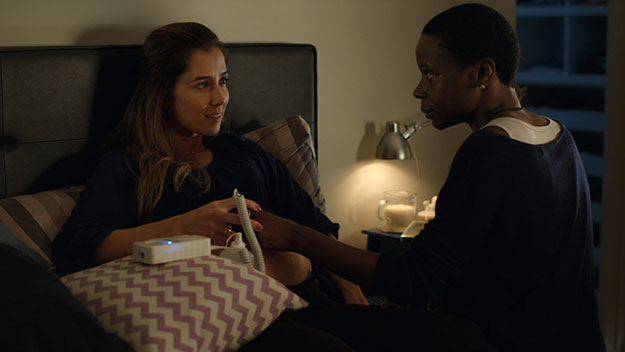
Good Manners
Following the more realist Hard Labor, which premiered at Cannes in 2011, Juliana Rojas and Marco Dutra’s new fiction feature is a rapturous, at times freewheeling tale that mixes social drama, horror, and even a touch of musical. In Good Manners, rich white socialite Ana (Marjorie Estiano) moves to São Paulo, pregnant and alone. She hires the taciturn Clara (Isabél Zuaa), who is black, to be her live-in nanny once she gives birth. But when Ana develops mysterious symptoms—violent pain, sleepwalking, and a ravenous appetite for raw meat—what looks like a faintly moralistic tale of two women’s budding love across class and racial divides turns into something much more complicated, and darkly fun.
“Our generation grew up on the video store, and I always found it funny that while the stores had all those genres [for foreign films]—horror, suspense, science-fiction, musical, even porn—our own cinema was always grouped as ‘national,’ as if we were undefined,” Dutra said in an interview at this year’s Locarno Festival, where Good Manners had its world premiere. “So now we have new Brazilian filmmakers who don’t accept any limits and are very open to playing with genres.”
Dutra cites a number of Brazilian films—Kleber Mendonça Filho’s Neighboring Scenes and Green Vinyl, Davi Pretto’s Rifle, Adirley Queiros’s White Out, Black In and There Was Once Brazilia (which also premiered at Locarno in August)—as examples of how genre elements ranging from dream sequences to entire fantastical scenarios can enhance cinema’s evocative power. In Rojas and Dutra’s case, the genre link goes deep into film history: their inspirations range from Jacques Tourneur (particularly his Hollywood horror films, Cat People, I Walked with a Zombie, Night with the Demon, and A Leopard Man), Hitchcock, Mary Poppins, and Disney’s fairytales.
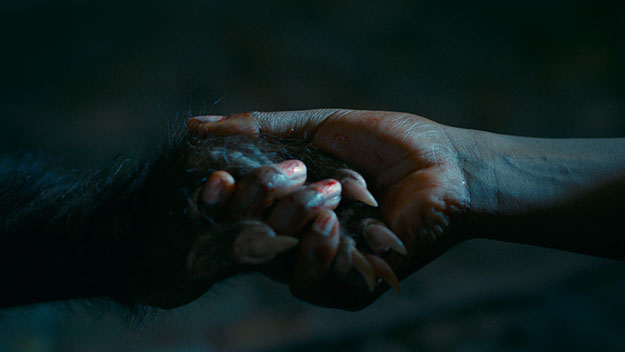
Good Manners
“We watched his films with our art director and director of photography to see his aesthetic solutions. Particularly the shadows and the rhythms of his montage,” Rojas says of Tourneur. Dutra adds: “His films had small budgets and so he needed to be very efficient. A shadow requires just an object and light. It isn’t very complex to create phenomenal effects. Tourneur’s films were also made in a studio, which gives them a sensation of artificiality and helps make his world seem detached from reality. This was very inspiring for us.”
In Good Manners, as Ana’s stomach swells and her nocturnal, subconscious aggression increases towards all living things, including Clara, the color palette darkens, from bluish grays to luscious indigoes and emerald-greens. By the time Ana delivers a monstrous werewolf-boy, Joel, the leap into fantasy is complete. To emphasize it, Rojas and Dutra use the classical Hollywood technique of matte painting. Delicately rendered by Brazilian artist Eduardo Schaal, portions of certain backdrops are painted by hand, creating an eerie, fable-like feel. Quaint instruments on the soundtrack, such as a harp combined with a flute and, in the end, a chorus, augment the ominous effect.
Good Manners might have ended there, on a Rosemary’s Baby note. Yet Rojas and Dutra boldly skip the story ahead seven years, shifting the focus entirely to Clara as a surrogate mother to Joel and an embattled protective figure. As Clara slowly and painfully comes to terms with the boy’s true nature despite all attempts to shield him from himself, she must confront her community’s angry reaction to the boy—and by extension, at her.
“We always knew that conflict would be part of the film’s structure. That is why we shift [the action] from São Paulo’s Expanded Zone, which looks like Dubai, full of shiny new buildings, to the periphery. We want viewers to face Brazil’s social abyss, with class and racial conflicts, and conservatism in politics. At the same time, our vision isn’t entirely negative,” Dutra said. Rojas adds: “In the end, our protagonists become conscious of who they truly are. They take a stand.”
Indeed, by the film’s conclusion, Clara and Joel fully reclaim their roles as outcasts and form a pact—not of blood but of profound empathy.
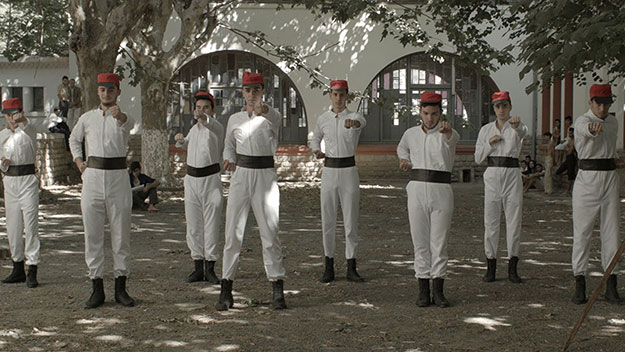
Le Fort des Fous
Narimane Mari’s approach to cinema is straightforward yet ingenious: we cannot speak of the past without speaking about memory. And memory, for Mari, is an active intervention, an opportunity not just to recall the facts and events but also to reshape them.
This dialectic is in play in Mari’s Le Fort des Fous (“Madmen’s Fort”), a meditation on Algeria’s violent colonialist past and on today’s generalized, global strife. (Her first feature, Bloody Beans in 2013, was a response to other Algerian filmmakers struggling to deal with the past.) To organize a theme so vast, Mari breaks her film into three parts. In the first, she films young Algerian men she cast via Facebook on the grounds of her old school, which, ironically, was once the Algerian house of Charles de Gaulle; in the second, shot on a rocky dreamlike beach, she films a group of disparate acquaintances whom she has invited to a Greek island, to create an imaginary escapist commune for two weeks; and finally in the third, she interviews Greek political activists.
“My film is about power and domination, but also about transgression,” Mari said in Locarno. Transgression is particularly important in the first part of Le Fort des Fous: the men play French colonial cadets who break up their training with trivial pursuits, such as taking pictures. “The French made a lot of propaganda pictures,” Mari explains. “So I invented a story of a young man who transgressed by making selfies with both Algerians and the French, creating his own community. The boy’s freedom is important; it shows his overturning order. My idea is that transgression is important, because you cannot stop it from happening.”
While not directly linked, the film’s second and third parts close the cycle of violence begun in part one with the war, while also revealing how transgression is reinterpreted in each social context. In the second part, Mari shares a utopian vision of escaping reality, while part three brings us face-to-face with the question of whether in today’s world it is possible to turn a blind eye, or for how much longer the answers to the global crises can be postponed.
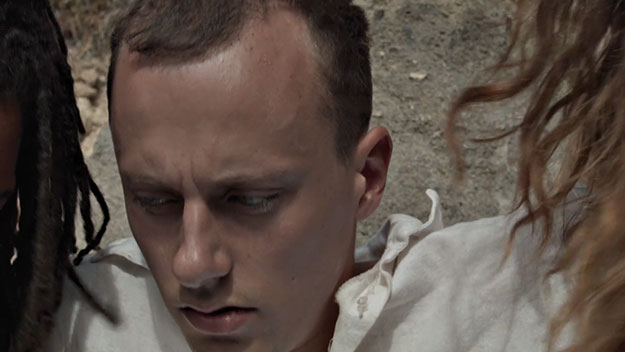
Le Fort des Fous
“My movie isn’t violent, but our current political situation is,” Mari said. “In my film, the activist I interview says, ‘Peace is only for the people who have security.’ He also says, ‘What I want is not what I hope,’ expressing the idea that sometimes war is necessary to destroy power. A lot of people don’t want to listen to this sentence, because it’s horrible. We can’t hear it, because we want to stay safe. But can we stay safe?”
Mari has a keen visual sense that leans towards theatrical. Hence the first part, saturated with deep marine colors and drenched in scorching light, contains many memorable tableaux: portraits of young men, their crisp blue-red uniforms a vision out of a Delacroix painting. And then there are the more absurdist touches, such as when, in one scene, the trainees dance with the life-size stuffed dolls that they had just stuck their bayonets into in training. When a young woman stitches up these same dolls, they lie strewn about the floor like corpses.
The fragmentation and repurposing extends to the soundtrack. In part one, Mari uses snippets from colonialist speeches, whose sounds are scrambled to resemble gibberish (the text is readable in subtitles), and links them to more current ones by Nicolas Sarkozy and Emmanuel Macron that betray a colonialist mindset. “I use this discourse,” Mari said, but then: “I want to remind ourselves that we are flesh, blood, eyes, and love. We possess the freedom not to be slaves of ideology, or order. That’s part of my dream, tu vois?”
Le Fort des Fous walks a fine line between fiction and nonfiction. In one scene, the Algerian boys talk, while playing fictional soldiers, about polishing foreigners’ shoes, the work they may very well take up today.
“My actors don’t go to school. So my message is really to the Algerians: why aren’t they in school? They want to learn,” Mari said. “I always work with my actors outside the film. I want to know what they think. They tell me that the Europeans and Americans look at them as if they were terrorists, or garbage. They know humiliation.”
As in Bloody Beans, there is an eerie sense of displacement in this scene—and in the entire film—between the past and present. In this sense, Algeria’s woes emerge as devastatingly persistent. Yet while the Shakespearean notion of “Blood will have blood” could neatly express the decades of conflict expressed in Mari’s two features and in the Greek activist’s ominous prognostication for the world, there is a deep humanist hope that even most vicious cycles get broken.
Ela Bittencourt works as a critic and programmer in the U.S. and Brazil and is a member of the selection committee for It’s All True International Documentary Film Festival.



